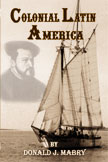|
Structure of the Spanish Colonial System
© 2001 Donald J. Mabry
- Differences among colonies as to wealth. New Spain was wealthy
whereas Paraguay was poor, for example.
- Crown enterprise in Spanish America was huge and spent a lot of
money.
- There were restrictions in terms of office; didn't like to keep
people in office too long. Wanted to keep officials from getting too embedded
in local areas..
- The Spanish mixed legislative, judicial, and executive functions.
There was no thought of the separation of power.
- The Crown tried to keep the ultimate authority in Spain, e.g. use of
the residencia. Spain was the court of last appeal. Crown encouraged
direct communication from colonists, making a great virtue out of this. Encouraged American
officials to spy on each other. Some did.
- Crown gave a very large degree of independence to revenue officials
such as the assayer, accountant, and treasurer. Viceroy couldn't
really discipline the royal officials.
- System had numerous guarantees against "Americanism." Used peninsulares
(Spaniards born in Spain) as opposed to criollos (Spaniards born in a colony)
in grand offices. Peninsulares in majority in inferior offices too. Assumed that the
peninsulares were intrinsically more loyal to the
Crown.
- Had the alliance of ecclesiastical and civil administrations which
was characteristic of the modern national dynastic state. Monarchs got control of the
church through the patronado, the control of major appointments of church officials
and control over Church revenues. Crown used this
power to bolster its own authority. The Church did tremendous amount to help civil
administration control this vast area. Demanded
obedience to authority. It pacified the Indians.
- System practiced thought control, asserting homogeneity in religious
and civil matters.
- Used mercantilism for its economic policy. Mercantilism was based on
the belief that only precious metals (principally gold and silver) were wealth and, thus,
the way to increase wealth was to acquire more precious metals through warfare, theft, and
trade. In trade, the ideal was to supply
one's own needs and wants while selling goods to theirs.
- Control of conquistadores. The Crown took take most of their
political power while leaving them economic power. The claim of being a conquistador was
recognized by the king as reason for favors but the Crown wouldn't allow rivals to its
power..
- The whole system of control was held together by paperwork,
documentary cement, a veritable flood of documents. There was too much to keep track of and
a tremendous amount of lying.
Ways to Categorize the System
- political-military system¾administration
courts officialdom, tax system, militia (very few land forces in America)
- economic system¾part of the whole
system of control . part of the way to hold empire together, to favor Spain and the upper
classes.
economic system enormously reduced ability of the lower classes to attack system
- ecclesiastical system
- social administration--part of others. System of noble titles, legal
class division, censorship, educational system
You can read about other topics in colonial Latin American history by buying and reading
 Colonial Latin America by Don Mabry. Colonial Latin America by Don Mabry.
Click on the book cover or the title to go to Llumina Press.
|

